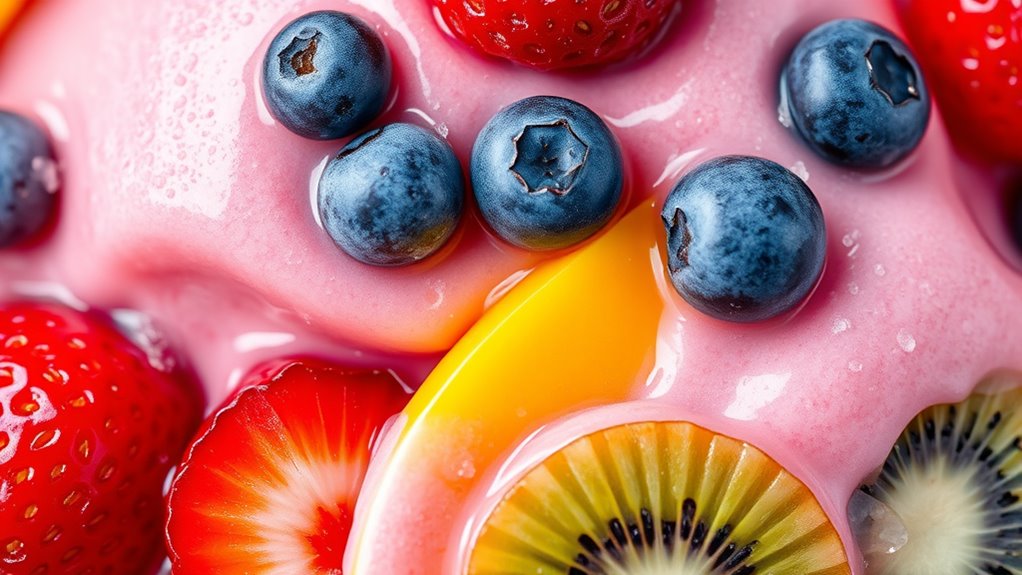Using frozen fruit in gelato offers you consistent flavor, quality, and nutrition year-round. Freezing quickly after harvest helps lock in nutrients and antioxidants, ensuring a healthier, more flavorful treat. Plus, frozen fruit is convenient and easier to process, producing a smooth, stable texture. While fresh fruit may vary in water content and affect texture, mastering proper preparation can elevate your gelato. Keep exploring to discover tips for ideal results with either option.
Key Takeaways
- Frozen fruit preserves flavor, nutrients, and antioxidants better over time than fresh fruit.
- Proper thawing and maceration of frozen fruit ensure optimal gelato texture and flavor.
- Fresh fruit may introduce excess moisture, risking icy texture; frozen fruit offers more consistent results.
- Freezing locks in nutrients and flavor, making frozen fruit a reliable, year-round option.
- Handling techniques like maceration help reduce water release from frozen fruit, maintaining creaminess.

Are you wondering which fruits work best in gelato? When choosing between fresh fruit and frozen, it’s important to consider how each impacts the final product.
Frozen fruit, like blueberries and raspberries, often outperforms fresh fruit in gelato because it retains flavor and antioxidants better over time. Freezing shortly after harvest locks in nutrients and flavor, resulting in a more vibrant taste compared to out-of-season fresh fruit. This makes frozen options especially appealing if you want consistent quality year-round.
Frozen fruits like blueberries and raspberries preserve flavor and nutrients better, ensuring vibrant taste year-round.
Using frozen fruit in gelato is more convenient than fresh because it’s ready to go and helps maintain a stable texture during processing. Fresh fruit can be more delicate and may vary in water content, which can affect the smoothness of your gelato.
When incorporating frozen fruit, it’s essential to thaw and macerate it first. Maceration softens the fruit and allows you to control excess water release, which, if unaddressed, can create ice crystals and compromise the gelato’s smoothness. Proper maceration ensures the fruit’s flavor is well preserved, and the texture remains creamy rather than icy.
In gelato making, flavor preservation is vital, and frozen fruit often offers an advantage here. Because freezing preserves nutrients, your gelato benefits from the antioxidants and vitamins locked inside. When you thaw frozen fruit before mixing, it releases some water, which can dilute the flavor if not managed properly.
That’s why maceration is key: it helps extract the fruit’s essence while reducing water content, ensuring your gelato stays rich and flavorful without becoming overly watery.
Texture is another essential aspect. Fresh fruit, if used directly, can sometimes introduce excess moisture that leads to an undesirable icy texture. Conversely, frozen fruit, when properly prepared, contributes a stable, consistent texture during churning.
This consistency allows for a smoother, more luxurious gelato experience. Also, since freezing halts enzymatic activity and spoilage, the fruit’s nutrients are preserved longer, giving you a healthier, more flavorful treat.
Frequently Asked Questions
Is It Better to Use Fresh or Frozen Fruit in Smoothies?
When choosing between fresh and frozen fruit for smoothies, you should consider quality and convenience.
Frozen fruit often retains more nutrients and flavor because it’s picked and frozen at peak ripeness, making it a better option for nutrition.
It also provides a thicker, creamier texture without extra ice.
Is Gelato Made With Real Fruit?
You might wonder if gelato is made with real fruit, and the answer is yes, it often is. Artisanal gelato recipes emphasize authentic ingredients, so they typically include fresh or properly prepared frozen fruit to guarantee genuine flavor.
Using real fruit, whether fresh or frozen, helps create that rich, natural taste and smooth texture that distinguishes quality gelato from artificially flavored options.
Do Fruits Lose Calories When Frozen?
Imagine you’re in the age of explorers, wondering if frozen fruits lose calories. The truth is, freezing doesn’t substantially change their calorie content.
You keep the same amount of natural sugars and carbs; only minor moisture loss might slightly concentrate sugars, but overall, frozen fruits are nutritionally similar to fresh ones.
Does Frozen Fruit Count as Fresh?
You might wonder if frozen fruit counts as fresh. It actually does, because freezing preserves most nutrients, flavor, and texture, making it just as healthy and fresh as fruit you buy in the store.
When fruits are frozen right after harvest, they retain their quality and nutritional value. So you can confidently use frozen fruit in your recipes as a fresh alternative, especially when fresh options aren’t available or out of season.
Conclusion
Whether you choose fresh or frozen fruits, remember they’re the vibrant heartbeat of your gelato. Fresh fruits are like sunlit mornings—bursting with life—while frozen ones are the silent guardians of flavor, ready to surprise anytime. Whichever you pick, you’re crafting a symphony of taste, a colorful dance on your palate. So go ahead, embrace both, and let your gelato be a delicious canvas where nature’s bounty shines in every scoop.









